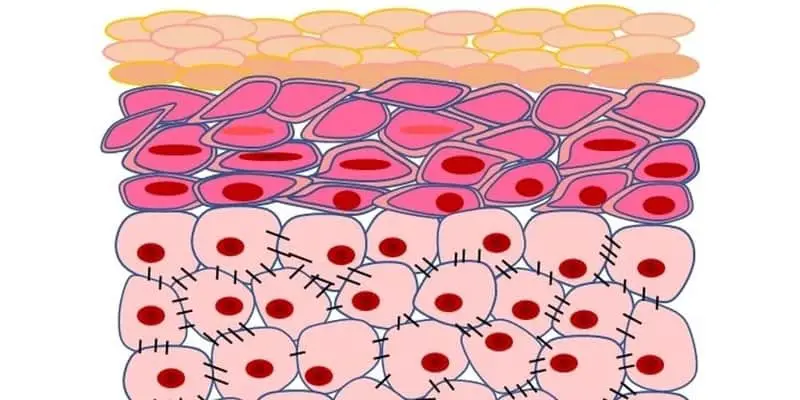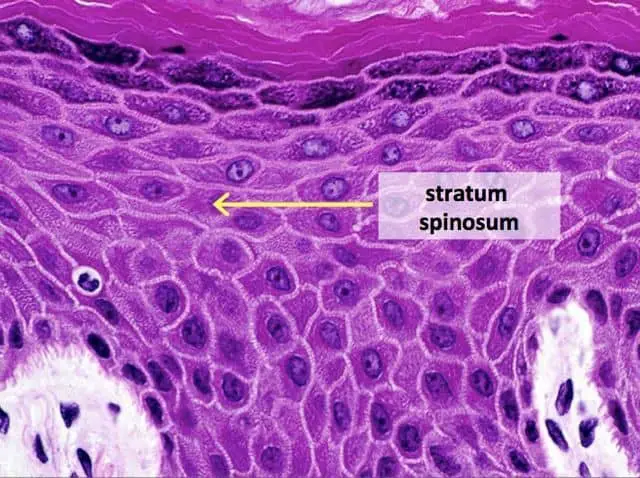If you’ve ever looked closely at you skin or the surface of a plant you may have not have known that you were looking at a large collection of epidermal cells. So what are epidermal cells?
Epidermal cells make up the epidermis – the outermost layer of cells in plants and animals which form a strong and protective coating or skin. The epidermis may be a single layer, as found in plants, or it may consist of many different layers as is the case of vertebrate animals. The main function of the epidermis is to act as the first line of defense protecting the structures underneath the skin from damage.
Keratinocytes make up around 90% of the epidermis. These cells produce the protein keratin in abundance. Keratin within the epidermis is not only found in human skin but also in many different species of animal. For example, it is found in nails, feathers, hairs, horns, and claws.
These appendages are created via modifications to the epidermis. These modified appendages are some of the strongest biological materials. This is because they are filled with keratin, which allows them to withstand stress, injury, and attack.
Human Epidermal Cells
Human epidermal cells make up part of the largest organ in the body, the integumentary system. This vital organ is composed of skin, nails, hair, and its associated glands. The skin covers the entire body protecting the layers below from various threats such as pathogens, UV light, trauma, chemicals, and water loss.
The skin is also able to provide insulation, aid in sensation as well as helping to regulate body temperature. The average human has around 300 million skin cells and the skin as an organ itself accounts for around 15% of our body weight.
What Is The Structure Of Human Skin?
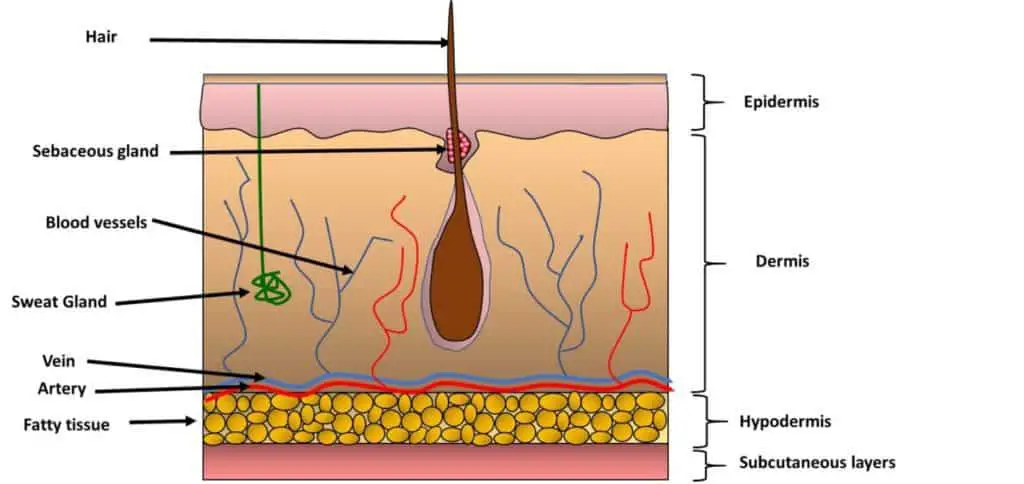
To understand the structure and function of the epidermis, we must first consider the layers that make up human skin. In vertebrate animals, the skin consists of 3 layers. The outermost layer is the epidermis, followed by the dermis, then the hypodermis, the innermost layer. It is worth noting at this point that epidermal cells have no direct blood supply, and so only obtain oxygen and nutrition via diffusion from small blood vessels in the dermis.
Importance of Keratinocytes
Keratinized stratified squamous epithelium makes up most of the cells in the epidermis. An epithelial cell is described as “keratinous” because the primary component found in epidermal cells is the protein keratin. Epidermal cells consist of keratinocytes, i.e. cells that produce the protein keratin.
Keratin is an extremely strong and resilient protein found in many epidermal components in animals. Examples of such are skin, hair, hooves, and feathers. Keratinocytes also help hold the epidermis together. The life cycle of a keratinocyte, from its generation to its removal by flaking off the skin is around 25 – 45 days.
Structure Of The Epidermis In Humans
In humans, the epidermis is made up of either 4 or 5 layers. Where it is made of 4 layers, it is described as “thin skin”. Where there are 5 layers, it is known as “thick skin”. The extra layer found in thick skin is called the stratum lucidum.
Thick skin is generally found in hairless areas of the body like the soles of the feet or the palms of the hands. The thinnest area of skin in the body is the eyelid measuring around 0.2mm in thickness. The thickest skin is found on the soles of the feet and measures around 1.4mm in thickness.
The 5 layers of the epidermis are:
- The stratum basale
- The stratum spinosum
- The stratum granulosum
- The stratum lucidum (in thick skin only)
- The stratum corneum
The stratum corneum is the outermost layer and the stratum basale is the innermost layer sitting next to the dermis. The image below shows the structure of the epidermis.
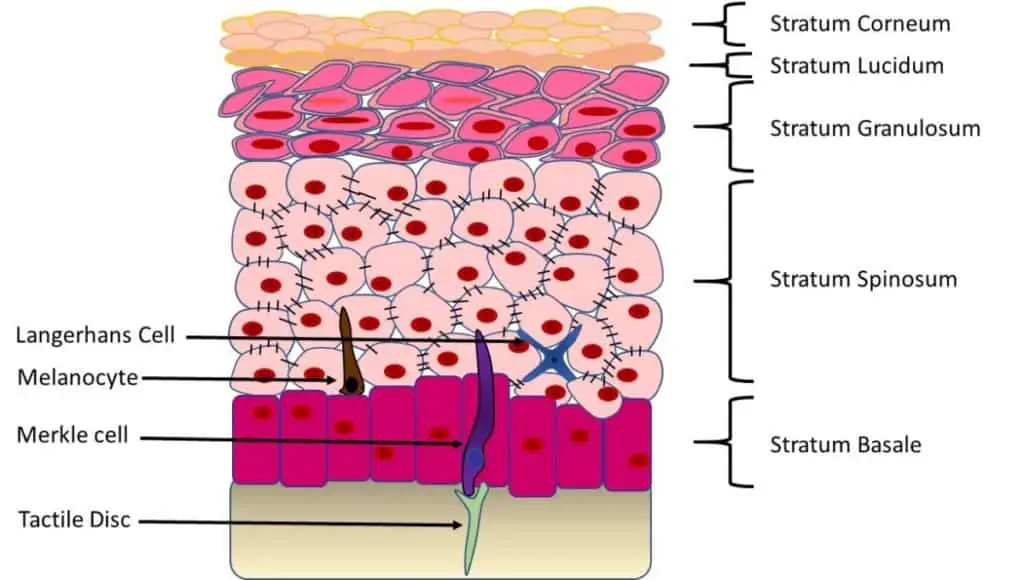
What Defines The Stratum Basale Layer?
The stratum basale, sometimes known as the stratum germinativum is the innermost layer of the epidermis. The cells here show a cuboidal or columnar shape. The stratum basale sits on a basement membrane which allows their separation from the dermis layer below. It is attached to the basement membrane by multiprotein complexes called desmosomes and hemidesmosomes which act as intercellular junctions. These complexes give structural support and strength to the epidermis.
The stratum basale layer is composed of 2 types of cells. These are keratinocytes and melanocytes. Other cells are also present at much lower quantities including Merkel cells. The structure and function of Merkel cells will be discussed later.
The majority of the cells in the stratum basale are keratinocytes. They multiply in the stratum basale by mitosis resulting in the generation of millions of additional keratinocytes each day. The keratinocytes have the energy to perform mitosis here due to their proximity to the capillaries in the dermal layer, allowing them to obtain oxygen and nutrients via diffusion through its cell membranes.
As new cells are generated, they push older cells further and further up towards the outer layers, this is how skin replenishes itself. As they move up through the layers, the keratinocytes change in shape and structure.
Melanocytes are the other main type of cell found in the stratum basale layer of the epidermis. These cells form melanin, a pigment that is found in skin and hair as well as parts of the eye (iris). Melanin gives color to the parts of the body in which they are found. The link below shows a video that describes what keratinocytes and melanocytes look like under the microscope.
Merkel cells are found in low concentration in the stratum basale. These cells were discovered in the 1800s by the German histopathologist Friedrich Merkel. They are sometimes known as tactile epithelial cells. They are only ever found right above the basement membrane, with the other side of their membrane connected to keratinocytes via desmosomes.
They act as type-1 mechano-receptors which sense only very delicate touch. Their membranes lie next to nerve endings allowing them to transmit sensory information. As they function to sense very light touch, they are found predominantly in the face, tips of the fingers, and in the lips allowing these areas to have heightened sensitivity.
Stratum Spinosum
The stratum spinosum is also known as the prickle layer, due to its appearance under the microscope. When the epidermis is prepared for microscopy, the areas between the desmosome connections in the stratum spinosum pull away, leaving the cells with a spikey, shrunken appearance.
The stratum spinosum is usually between 8 and 10 cells in thickness. The shape of the cells now has changed from cuboidal as seen in the stratum basale, to polyhedral as they are pushed out of the stratum basale and into the stratum spinosum.
Langerhans cells are also found in the stratum spinosum. These are a type of dendritic cells of the immune system. They function to aid the immune system by recognizing invading pathogens or allergens. Once detected, they move into the lymph nodes where they activate the immune system. Langerhans cells are found next to keratinocytes in the stratum spinosum but also help in the layer below, the stratum granulosum.
In this layer, the keratinocytes have begun to produce the protein keratin. This protein is extremely strong and fibrous. At this stage, the keratin functions to keep water inside the cells. Cytoplasmic protein structures, called tonofibrils are present in each keratinocyte. They provide a structural support role.
Stratum Granulosum Layer
At around 3-5 cells thick, the stratum granulosum contains cells that have become slightly flattened in shape, sometimes resembling diamonds. The cells are now beginning to produce a lot more keratin and keratohyalin. Keratohyalin is a protein found in granules known as keratohyalin granules.
They surround the filaments of keratin and create an intercellular matrix. Also seen in the stratum granulosum are lamella bodies or lamellar granules. These granules consist of enzymes alongside glycolipids and proteins and are described as secretory organelles. They keep the cells close together by acting like glue and help prevent water loss from the cells by making them waterproof.
By creating this watertight barrier around the cells, they begin to be starved of nutrients and oxygen and ultimately this process facilitates their death. This is seen in the external layers of the stratum granulosum as well as the following layers of the epidermis. The dead cells in this layer can be observed in microscopy by their lack of nuclei. As the cells die, they become more flattened in appearance.
Stratum Lucidum In Thick Skin
The stratum lucidum is usually around 2 – 3 cells in thickness and is clear in appearance. It is only present in thick skin found on the hairless areas of our body where the skin is very thick. examples of such are the soles of the feet and the palms of the hands. The keratinocytes in this layer are dead and absent of nuclei due to their inability to obtain nutrients.
Stratum Corneum
The final layer of the epidermis is the stratum corneum; the topmost layer, with a thickness of 20 -30 cells. All the keratinocytes in this layer are dead and filled with keratin. The cells have become cornified and flattened. This layer is sometimes known as the horny layer due to its high keratin content and low water content.
The keratinocytes can now be described as corneocytes. These dead cells are removed into the environment easily, in a process known as skin shedding. Our skin is consistently shedding dead cells, with between 30,000 and 40,000 cells being shed every minute! The corneocytes release defensins, antimicrobial peptides which aid the immune system.
They are found to interfere in the channels of bacterial membranes, altering their water uptake and ultimately resulting in their death. Defensins are also thought to act against fungi and some viruses. The image below shows how the layers of the skin look under the microscope.
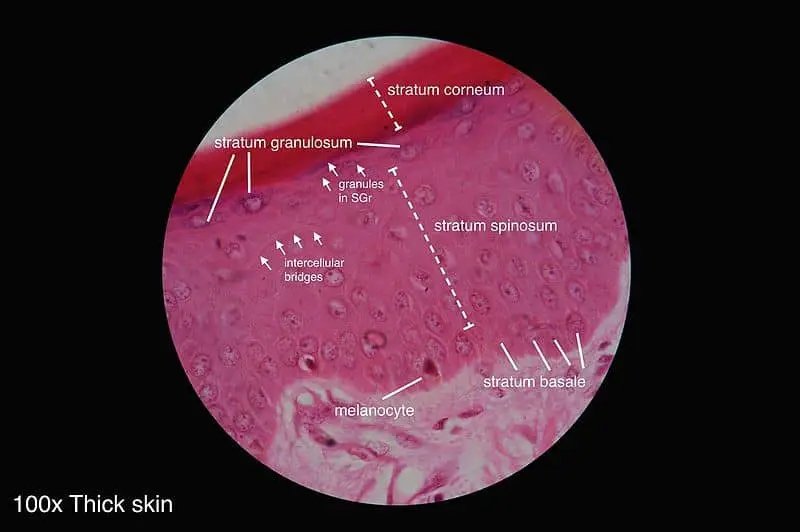
Epidermis Function
There are many roles of the epidermis (Figure 5). As well as functioning as a protective barrier to the layers underneath the skin, it also has many other vital functions. The list below gives the main functions which will be discussed in further detail:
- Waterproof layer
- Immune defense
- Protection against ultraviolet light
- Structural integrity
- Body homeostasis
- Sensation
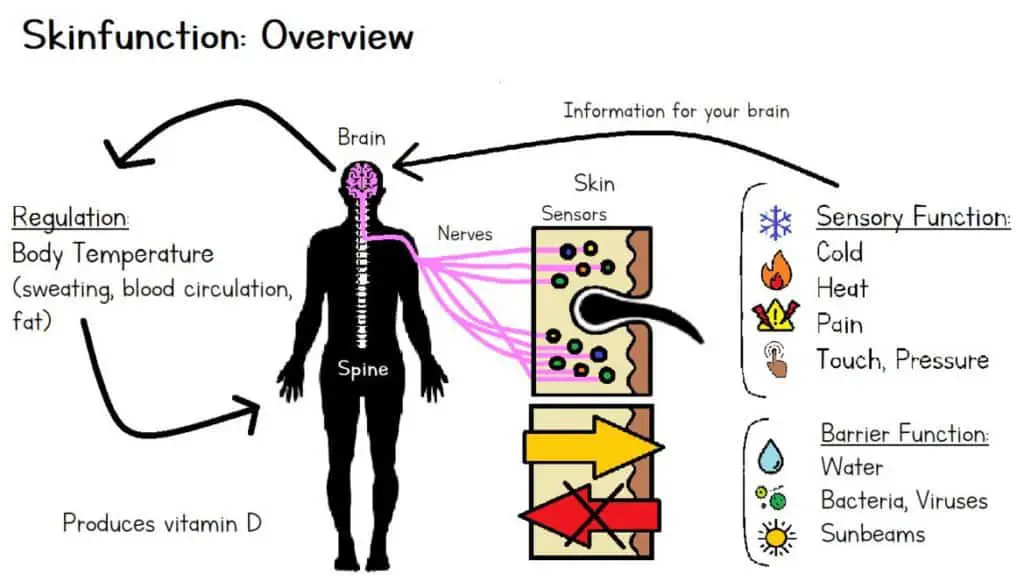
Water Barrier
The epidermis functions as a barrier against water. Sebaceous glands, a type of apocrine gland secretes sebum, an oil made of proteins and lipids. This oil coats the hairs and surrounding skin which protects from water loss. The sebaceous glands are located in the dermis layer of the skin, but the oil passes up the hair shaft and spreads over the outer layers of the epidermis. Sebaceous glands are only found in hairy areas of the skin. Overactive sebaceous glands are seen in individuals suffering from acne or hyperplasia.
At a molecular level, the epidermal cells have a hydrophobic inner plasma membrane, and the outer surface membrane is also hydrophobic. In the stratum spinosum layer of the epidermis, the lamella granules are exported to the intracellular spaces. The contents of these lamella granules contain phospholipids, glycosphingolipids, and ceramides which are then incorporated into the extracellular membrane.
The resulting membrane can then block the uptake of water. Claudin and desmoglein are both essential proteins found in the epidermis. They are involved in the prevention of water loss from the epidermis. Claudin is an important protein component of tight junctions which are involved in allowing the flow of molecules into and out of the epithelium.
Desmogleins are proteins found in desmosomes, the intercellular junctions between the epithelial cells which provide structural support and keep the cells close to one and another to avoid water seeping between them.
Immune Defense
The epidermis also provides a barrier to chemicals and microbes. Fatty acids in the lamella granules are antimicrobial, protecting the skin from invading pathogens. Lamella granules also release defensins, antimicrobial chemicals that also act against pathogens.
Protection Against Ultraviolet Light
UV radiation can cause inflammatory responses in the skin, skin cell death (apoptosis), and DNA damage. All of which can lead to premature aging and cancer. Melanocytes in the epidermis can filter out UV light. The protein melanin gives our skin its color. Those with more melanin will have darker skin than those that only produce a small amount of melanin.
Exposure to sunlight can increase the production of melanin within melanocytes, acting as a protection against UV. However, this increase in melanin production varies from one person to another. Those people with darker skin have more melanin production in their melanocytes and therefore can filter out more of the harmful UV radiation. These individuals are less prone to developing skin cancer and premature wrinkles.
Structural Integrity
The layers of the skin have a vast amount of strength and elasticity. Although collagen in the dermis layer of the skin is one of the most important and well-documented proteins involved in strength and elasticity, keratin in the epidermis also helps to contribute to the overall strength of the skin.
Keratin is very fibrous giving it strength. As the layers of the epidermis progress outwards, the keratinocytes fill with more and more keratin, leaving a protective layer against injury and damage. The epidermis protects the underlying dermis and the hypodermis.
Body Homeostasis
The skin helps to maintain body homeostasis in many ways. Examples include water balance, synthesis of vitamins and hormones, temperature regulation, and the absorption of substances. We will look at 2 of these examples; 1. Temperature regulation and 2. Vitamin D production.
Temperature Regulation
The epidermis helps the body to regulate its temperature. It can do this by allowing the skin to sweat when the body is too hot. Sweat glands, a type of eccrine gland secretes water and salts in response to a high body temperature.
The sweat on the surface of the skin then cools the body down. When the body temperature drops, the sweat glands constrict, and sweating is ceased. Sweat glands are found in abundance throughout the skin. Similarly, the hairs on the body stand up on end when the body is cold. This traps air around the skin and warms it up.
Vitamin D Production
Vitamin D is produced in the epidermis of the skin. This process occurs in the stratum spinosum and the stratum granulosum layers. Here, the keratinocytes convert 7-dehydrocholesterol into vitamin D. This chemical reaction is aided by the help of sunlight.
Keratinocytes contain a vitamin D receptor and enzymes which allow the chemical process of the formation of vitamin D to take place. The activation of the vitamin D receptor also stimulates the production of more keratinocytes in the stratum basale. The image below illustrates the synthesis of vitamin D and its use by the body.
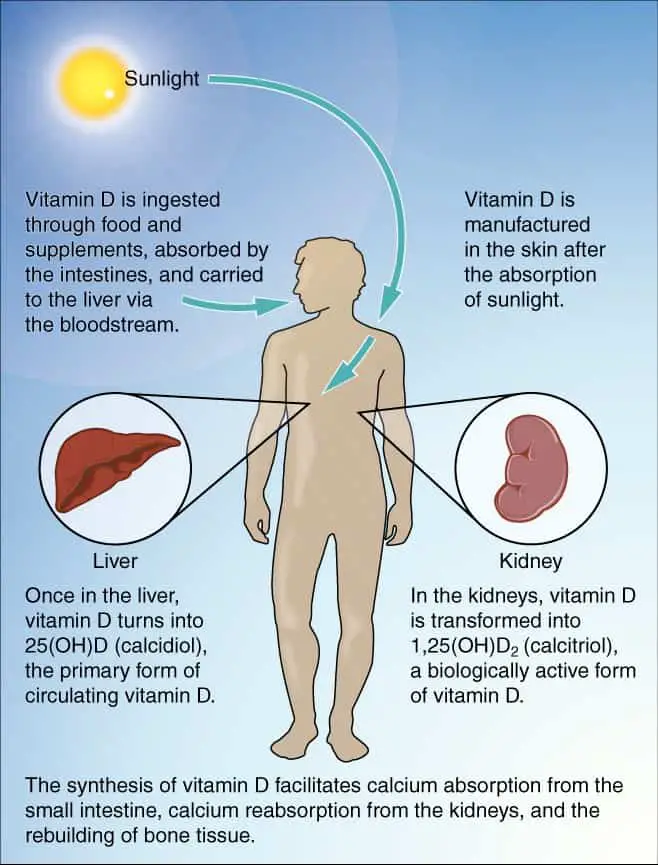
Sensation
Merkel cells are the component in the epidermis that serve as mediators of the perception of delicate touch. Merkel cells are found in touch domes, which are clusters of Merkel cells. As well as Merkel cells, the epidermis also contains free nerve endings that transmit sensory information. This allows us to register temperature and pain.
Epidermis Of Plants
The epidermis is not just a tissue structure found in animals and humans. It is also seen in the outside layer of plants. However, in comparison to the epidermis in vertebrates, it is much simpler, consisting of only 1 simple layer at 1 cell in thickness. There are some varieties of plants that have multiple layers, for example, some xerophytes.
These plants have adapted to survive conditions with very little water and therefore need extra layers to protect from water loss out of the leaves. The epidermis in plants consists of simple epidermal cells, guard cells, and associated hairs/projections. The epidermis is found covering leaves, stems, flowers, and roots. On the epidermis of leaves, guard cells surround a pore known as the stomata.
These pores let gas exchange occur which is vital to allow the plants to ‘breathe’. Epithelial cells contain no chloroplasts, but guard cells do. Chloroplasts contain chlorophyll, a green pigment that allows the plant to absorb sunlight to generate food. As epidermal cells do not contain chloroplasts, they are clear, allowing sunlight to reach the layers below and therefore do not block important light to chloroplast containing cells below. the image below shows a microscopic image of a tulip leaf at 600x magnification.
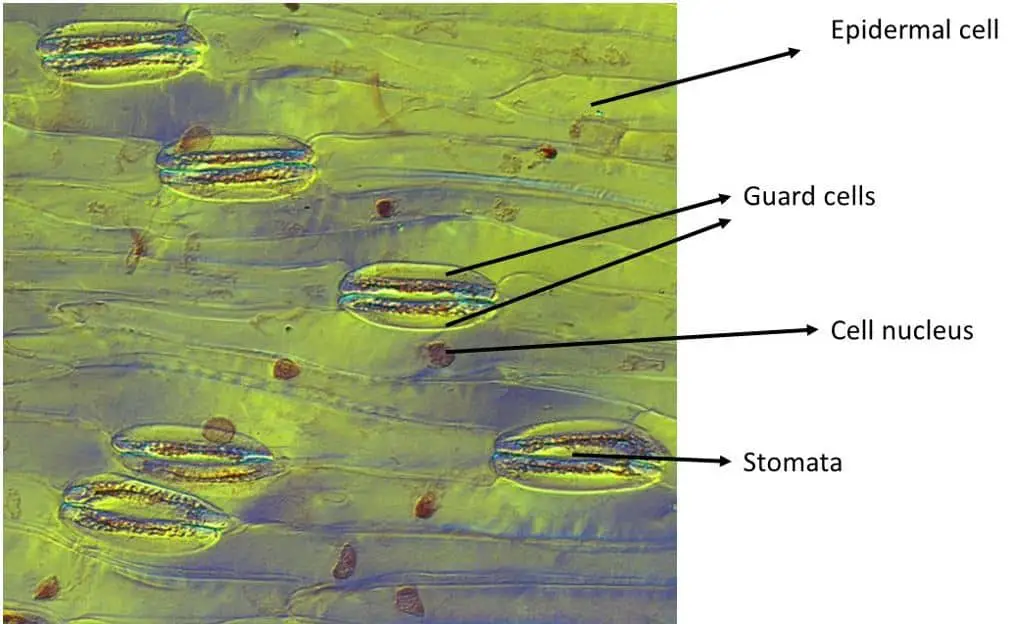
In the non-woody portion of above-ground parts of plants, there is a cuticle that covers the outside portion of the epidermal cell walls. This is a waxy coating that due to its hydrophobicity creates a barrier against water. The cuticle also helps to keep pathogens out. Another waxy layer known as an epicuticular wax provides further protection from strong winds and UV radiation.
The composition of wax in plants varies depending on their environment, for example, in arid conditions or cold harsh environments, plants often have a thicker waxy layer. The epicuticular layer can absorb some of the UVB radiation from the sun as well as being able to reflect some of it. This protects the layers below the epidermis.
The roots of plants are also covered by an epidermal layer. In the roots of plants, the epidermal layer is very thin as it needs to allow the uptake of water into the plant. As mentioned above, the epidermis protects from water loss and is fundamentally hydrophobic, therefore, it is beneficial to the plant that the epidermal layer in the roots is as thin as possible. Roots can also produce a substance called mucigel.
This is a hydrophilic carbohydrate that lubricates the root allowing it to progress through the soil as it grows and allows water to move into the cells easily. Furthermore, the epidermis of roots has specialized root hair cells that increase the surface area for the uptake of water and nutrients. Also found within the epidermis of plants are trichomes. These are hair-like extensions that protect the plant from pests such as insects or herbivores.
Trichomes can make the surface of the leaf inaccessible by resembling hairs or spikes, which make the leaves unappealing to herbivores or difficult for insects to walk on. The epicuticular wax can also make the leaves unappealing to insects by creating a very slippery surface so insects cannot grip them. Trichomes can also secrete toxic chemicals.
When they are broken off by animals, their toxins irritate the skin. Other plants such as carnivorous plants (e.g. Venus flytrap) can secrete sticky chemicals that attract insects allowing them to be digested by the plant. The image below shows an example of a plant with trichomes which gives it a hairy appearance.
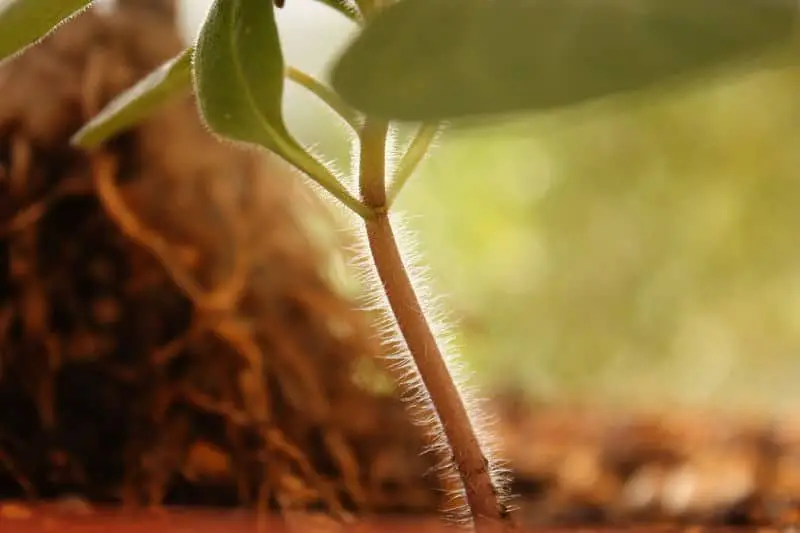
Takeaways
The epidermis is vital for both plants and animals by acting as a protective layer against environmental damage. In humans and animals, the list of functions that the epidermis provides is long, from temperature regulation to immune defense. The variation in keratin content and structure enables the formation of different epidermal appendages to provide extra protection and defense.
In this way, animals have adapted to their environments. Similarly, the epidermis of plants living in harsh environments is suitable to protect from wind and sunlight. As the skin is an organ, its overall health is extremely important due to its multiple functions. The appearance of someone’s skin gives us an idea of their general wellbeing and age.
References
- Barbieri, J.S., et al. (2014). Skin, Basic Structure and Function. Pathology of Human Disease. 1134-1144. https://doi.org/10.1016/B978-0-12-386456-7.03501-2
- Borradori, L., Sonnenberg, A. (1999). Structure and Function of Hemidesmosomes: More than Simple Adhesion Complexes. Journal of Investigative Dermatology. 112(4) 411-418. https://doi.org/10.1046/j.1523-1747.1999.00546.x
- Cole, A.S., et al. (1988) Epithelium. Biochemistry and Oral Biology. 26 (2) 400-405. https://doi.org/10.1016/B978-0-7236-1751-8.50033-8
- Di Meglio, P., Conrad, C. (2016). Psoriasis, Cutaneous Lupus Erithematosus and Immunobiology of the Skin. Encylopedia of Immunobiology. 5, 192 – 203. https://doi.org/10.1016/B978-0-12-374279-7.15008-8
- Feingold, K, R. (2012). Lamella Bodies: The Key to Cutaneous Barrier Function. Journal of Investigative Dermatology. 132, 1951 – 1953. https://core.ac.uk/download/pdf/82781113.pdf
- Fenner, J., Clark, R.A.F. (2016) Chapter 1. Anatomy, Physiology, Histology, and Immunochemistry of Human Skin. Skin Tissue Engineering and Regenerative Medicine. (1) 1-17. https://doi.org/10.1016/B978-0-12-801654-1.00001-2
- Hogan, M.B., Peele, K., Wilson, N.W. (2012). Skin Barrier Function and its Importance at the Start of Atopic March. Journal of Allergy. Volume 2012, Article ID 901940, 7 pages. https://doi.org/10.1155/2012/901940
- Honari, G., Maibach, H. (2014) Skin Structure and Function. Applied Dermatotoxicology. 1, 1-10. https://doi.org/10.1016/B978-0-12-420130-9.00001-3
- Kobielak, K., et al. (2015). Skin and Skin Appendage Regeneration. Translational Regenerative Medicine. 22, 269-292. https://doi.org/10.1016/B978-0-12-410396-2.00022-0
- Lopez, F.B., and Barclay, G.F. (2017) Plant Anatomy and Physiology. Pharmacognosy. 4, 45-60. https://doi.org/10.1016/B978-0-12-802104-0.00004-4
- Mostafa, W. Z., & Hegazy, R. A. (2015). Vitamin D and the skin: Focus on a complex relationship: A review. Journal of advanced research, 6(6), 793–804. https://doi.org/10.1016/j.jare.2014.01.011
- The Skin. Lumen Boundless Anatomy and Physiology. https://courses.lumenlearning.com/boundless-ap/chapter/the-skin/
- Sawamura, D., Goto, M., Shibaki, A. et al. (2005) Beta defensin-3 engineered Epidermis Shows Highly Protective Effect for Bacterial Infection. Gene Ther. 12,857–861. https://doi.org/10.1038/sj.gt.3302472
- Skin Fun Facts. (2017) Forefront Dermatology. https://forefrontdermatology.com/skin-fun-facts/
- Sotiropoulou, P.A. and Blanpain, C. (2020). Development and Homeostasis of the Skin Epidermis. Cold Spring Harbour Perspectives in Biology. https://cshperspectives.cshlp.org/content/4/7/a008383.full
- Wang, B., et al. (2016). Keratin: Structure, Mechanical Properties, Occurrence in Biological Organisms, and Efforts at Bioinspiration. Progress in Materials Science. 76, 229-318. https://doi.org/10.1016/j.pmatsci.2015.06.001
- What is a Merkel Cell? Merkelcell.org. https://merkelcell.org/about-mcc/what-is-a-merkel-cell/#:~:text=Merkel%20cells%20are%20found%20in%20the%20epidermis,outer%20layer%20of%20the%20skin).
- Yousef H, Alhajj M, Sharma S. (2020). Anatomy, Skin (Integument), Epidermis. StatPearls [Internet]. Treasure Island (FL): StatPearls Publishing. https://www.ncbi.nlm.nih.gov/books/NBK470464/

